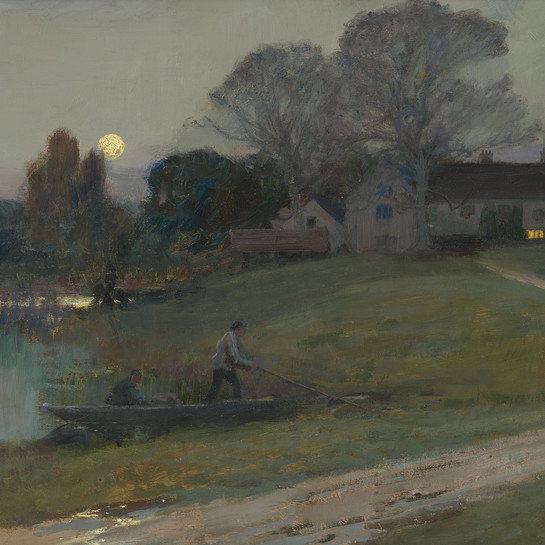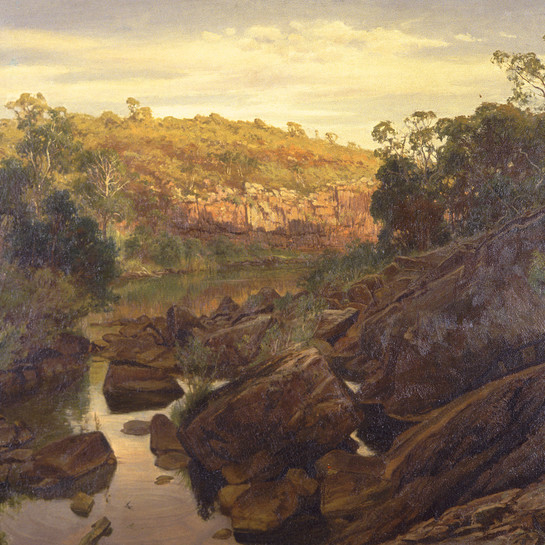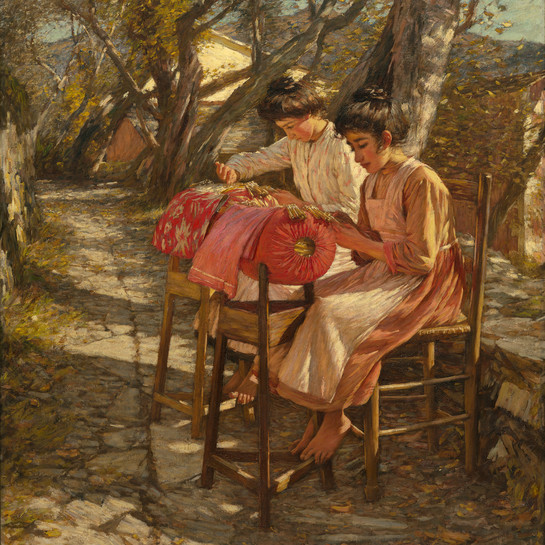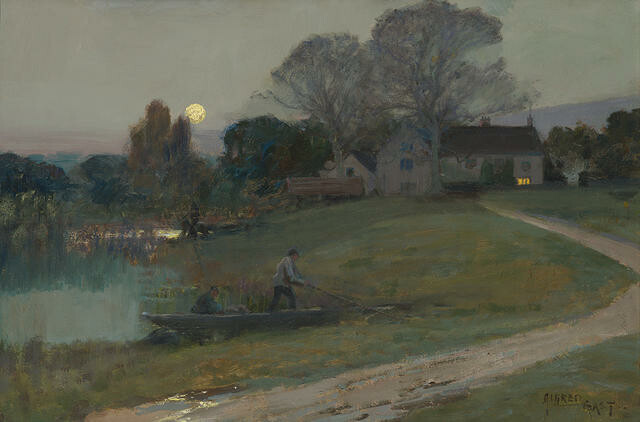Sir Alfred East
British, b.1844, d.1913
The Moon and the Manor House
- c. 1894
- Oil on canvas
- Bequeathed by Hayden R I Fraser, January, 1975
- 695 x 900 x 95mm
- 75/10
- View on google maps
Tags: boats, buildings (structures), cottages, houses, moonlight, night, paths, people (agents), rivers, trees
London-based artist Alfred East painted The Moon and the Manor House at Upper Swell village in the Cotswolds, where he kept a small studio from the 1890s. This evocative composition is one of ninety-five paintings he showed in 1895 in English Landscapes: illustrating the Effects from Dawn to Moonrise, his third exhibition with the Fine Arts Society in London. While studying at the Académie Julian in Paris from 1881, he was influenced by the work of Jean-Baptiste-Camille Corot, among others. East was born into a shoemaking family in Kettering, Northamptonshire. He spent two decades in this industry before dedicating himself fully to painting, after taking night classes at the Glasgow School of Art while managing his brother’s boot factory there in the 1870s. East settled with his family in London in 1884, held his first exhibition at the Fine Arts Society in 1888 and then was sponsored to spend six months in Japan in 1889 – the first English artist to work extensively in that country. He became one of Britain’s best- known painters and remained an inveterate traveller, working also in France, Spain, Italy and North Africa.
(The Moon and the Manor House, 12 November 2021 – 1 May 2022)
Exhibition History
Endless Light, 29 June 2019 – 8 March 2020
English artist Alfred East established a peerless reputation as a maker of poetic landscapes, able to envelop his views in mystery and mood. This quiet work forms part of a suite of ninety-five works that comprised East’s 1895 exhibition, English Landscapes: Illustrating the Effects from Dawn to Moonrise. We can clearly see men setting out for some night fishing by a full moon so powerful the night is clear in colour, form, shadows and silhouettes. East’s brushwork is reminiscent of Rodin’s handling of clay – thick, pushed and teased out, left to suggest rather than tell in obsessive detail.
(Endless Light, 29 June 2019 – 8 March 2020)
The Weight of Sunlight, 16 September 2017 - 16 September 2018
Alfred East built an unrivalled reputation in England as a painter of poetic landscapes and ‘moods of nature’. This harmonious composition is one of ninety-five small works shown in London in 1895 in his exhibition English Landscapes, illustrating the Effects from Dawn to Moonrise. Here, the low moon and its reflections in the village millpond and foreground puddle are balanced by a glowing window in the old manor house. The location is Upper Swell in the Cotswolds, where East had a studio. Born into a shoemaking family in Kettering, Northamptonshire, East remained in the industry for the first two decades of his working life. His first night classes in art were taken while managing his brother’s boot factory in Glasgow in the 1870s, but he left the family firm in 1881 to study further in Paris. East settled in London with his family in 1884, and became one of the best-known landscape painters in Britain, working also in Japan, France, Spain, Italy and North Africa.
Alfred East had a particular skill in painting pastoral scenes, capturing the atmospheric effects of light on the landscape at different times of the day. Here there is an atmosphere of calm, with only the sparkle of moonlight and the warm golden glow of the farmhouse window shining in the gathering darkness. The location of this scene is not known, but East's subject matter was usually derived from the Cotswolds, Cornwall or the Lake District. He made studies out of doors and completed his works in his studio. Born in Kettering, Northamptonshire, East’s parents opposed his career as an artist and, in 1874, sent him to Glasgow on business relating to his brother’s shoe factory. East began evening classes at the Government School of Art in Glasgow and, in 1880, left for Paris to study at the École des Beaux-Arts and then at the Académie Julian. East settled in London in 1884 and had a very successful career. He was knighted in 1910. (Opening hang 2003)
Specialising in pastoral landscapes at different times of the day, East has focused here on a nocturnal, or moonlight scene. Capturing the passing mood of nature rather than a specific place, he presents a tranquil scene of quiet mystery as the men embark on an undisclosed venture. The calmness is heightened by the carefully muted tones, with only the sparkle of moonlight and the warm golden glow of the farmhouse window shining in the gathering darkness. Influenced by the French Barbizon painters and especially by Corot's atmospheric landscapes, East gathered the material for his works 'plein air' sketching and making colour studies out of doors. As an etcher, East frequently drew out of doors and directly on the plate for his atmospheric landscape prints. (before 2002)





